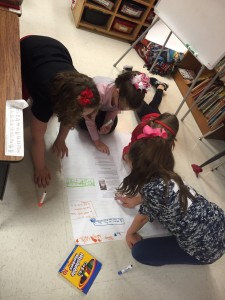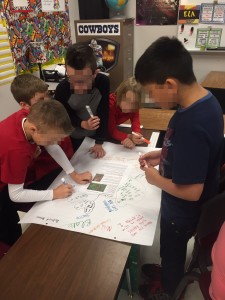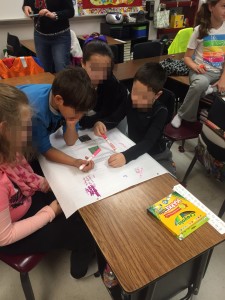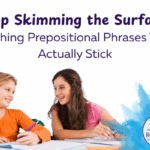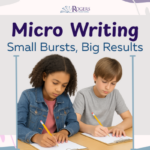** Contact us if you would like to have modeled lessons or workshop-style sessions come to your campus! **
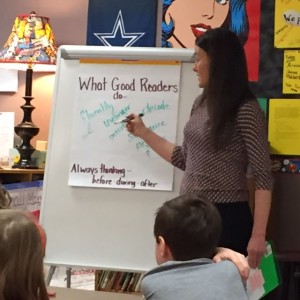 Last month I had the pleasure of modeling a think-aloud in third grade. I was asked to model the process of sharing with students the reading strategies I am using as well as the Gradual Release of Responsibility model. I was thrilled and couldn’t wait to meet the students.
Last month I had the pleasure of modeling a think-aloud in third grade. I was asked to model the process of sharing with students the reading strategies I am using as well as the Gradual Release of Responsibility model. I was thrilled and couldn’t wait to meet the students.
Modeling think-alouds has come to the forefront of reading instructional strategies. Teachers know that it is important to model for students what they are thinking as they read in order to help students internalize the process themselves, but few of us have been taught or shown how to do this. Ultimately we want all the students in our class to become metacognitive in their reading. We want students to be able to monitor their own thinking and aware of when the text makes sense and when it doesn’t. In order for students to be able to do this process, we need to model how to monitor comprehension. In my model lesson, I chose an article from Read Works on roller coasters. It is super important to pick something that you can get your students excited about. Since I was going to be in a third-grade classroom, roller coasters would definitely work! If I were to come back again, I would read Roller Coaster to connect to the informational text and use as a writing mentor text.
We began by discussing what good readers do when they read. The students all knew of some things. Some students said predict, a few mentioned rereading (that was exciting), and many shared that you had to use context clues. We began creating an anchor chart to remind ourselves about what to do when reading. I prompted the students to add making connections, monitor comprehension, and ask questions to the anchor chart.
Once the anchor chart was started, I displayed my article on the Smart Board in the classroom. How cool is that? When I was still in the classroom full-time I had a rickety and temperamental overhead projector. I explained to students that when given informational text we first need to read the title and think about what we already know on the topic and what we think the text might tell us. Since the title of mine was “Are Roller Coasters Safe?” we had a lot to discuss. I wrote down some notes beside the title. Then I explained we had to read subtitles and do the same and then move on to visuals (pictures, charts, graphs, etc.). Last we looked for bold words or words that were underlined. We added new strategies to our anchor chart and then we were ready to read.
As I read the text out loud to the students, I stopped every so often to check my predictions, ask questions, and monitor my comprehension (as those were the strategies I was focused on), but the anchor chart had more for the students to think about. By the end of the article, the students and I were all really interested in learning more about roller coasters and I believed many students went to look up facts about roller coasters after I left. The truth is, it wasn’t the article alone that sparked their interest, it was the discussion and collaboration we were having that sparked a passion within the students.
During my model lesson, we were engaged in the “I do” and “we do” stages of the Gradual Release Model. We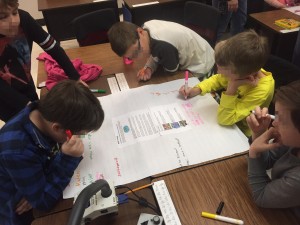 were hitting two of the three stages at once because I was modeling and doing most of the work, but the students began joining in as we continued to read. When the lesson was finished, instead of jumping into the “you do it alone” stage, I felt that the students needed time to “do it together.” They needed to interact with the strategies in the safety of a group in order to master the skill. I chose different articles that would also be interesting to the students and glued them in the center of a large piece of chart paper. In groups of three and four, I asked each student to get a different color marker. Each student was asked to write their name at the top in their color. Then I had the students read the title and predict and activate their schema like I did and then write it on the side on the chart paper. We then moved on to subtitles, visuals, and vocabulary. Then I released responsibility to the students and asked one student to read aloud and stop at specific stopping points. At those points, ALL students in the group were to write their thinking in their color on the paper. They would continue this till they were finished. I have to be honest, the students loved this more than I had expected. They were writing with markers, on chart paper, in groups. They didn’t want to stop! While they were writing, the other teachers and I walked around and listened to students conversations and thinking. They were all using great strategies. If I had been the teacher of record, I would have been walking around with a clipboard and been writing anecdotal notes of how the students were thinking. This would be used as a formative assessment to inform my future instruction.
were hitting two of the three stages at once because I was modeling and doing most of the work, but the students began joining in as we continued to read. When the lesson was finished, instead of jumping into the “you do it alone” stage, I felt that the students needed time to “do it together.” They needed to interact with the strategies in the safety of a group in order to master the skill. I chose different articles that would also be interesting to the students and glued them in the center of a large piece of chart paper. In groups of three and four, I asked each student to get a different color marker. Each student was asked to write their name at the top in their color. Then I had the students read the title and predict and activate their schema like I did and then write it on the side on the chart paper. We then moved on to subtitles, visuals, and vocabulary. Then I released responsibility to the students and asked one student to read aloud and stop at specific stopping points. At those points, ALL students in the group were to write their thinking in their color on the paper. They would continue this till they were finished. I have to be honest, the students loved this more than I had expected. They were writing with markers, on chart paper, in groups. They didn’t want to stop! While they were writing, the other teachers and I walked around and listened to students conversations and thinking. They were all using great strategies. If I had been the teacher of record, I would have been walking around with a clipboard and been writing anecdotal notes of how the students were thinking. This would be used as a formative assessment to inform my future instruction.
While I didn’t have time in this lesson, the next step would be the students completing this activity on their own. The individual papers would be collected and graded on a rubric based on what strategies were being used.
In reflection, this lesson really went well. The groups were differentiated based off of the Lexile level of the text, the students were engaged and held accountable, and I was able to gain useful information about the strategies the students used as they read. If I had to change anything, I would probably have modeled the lesson with a more “meaty” text, one possibly above the students reading level that would challenge them, and give me more to model.
What are your tricks for modeling reading strategies?
